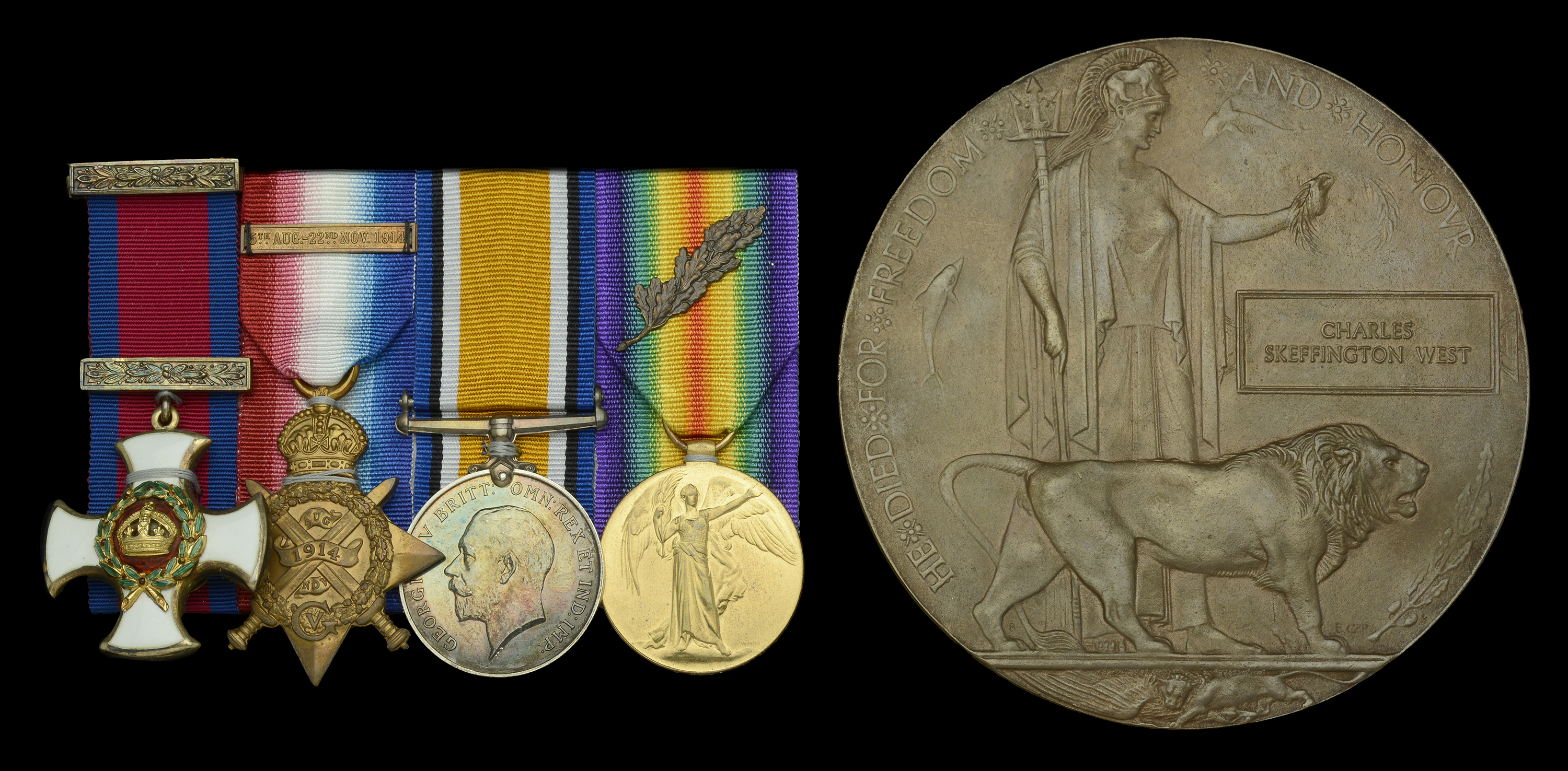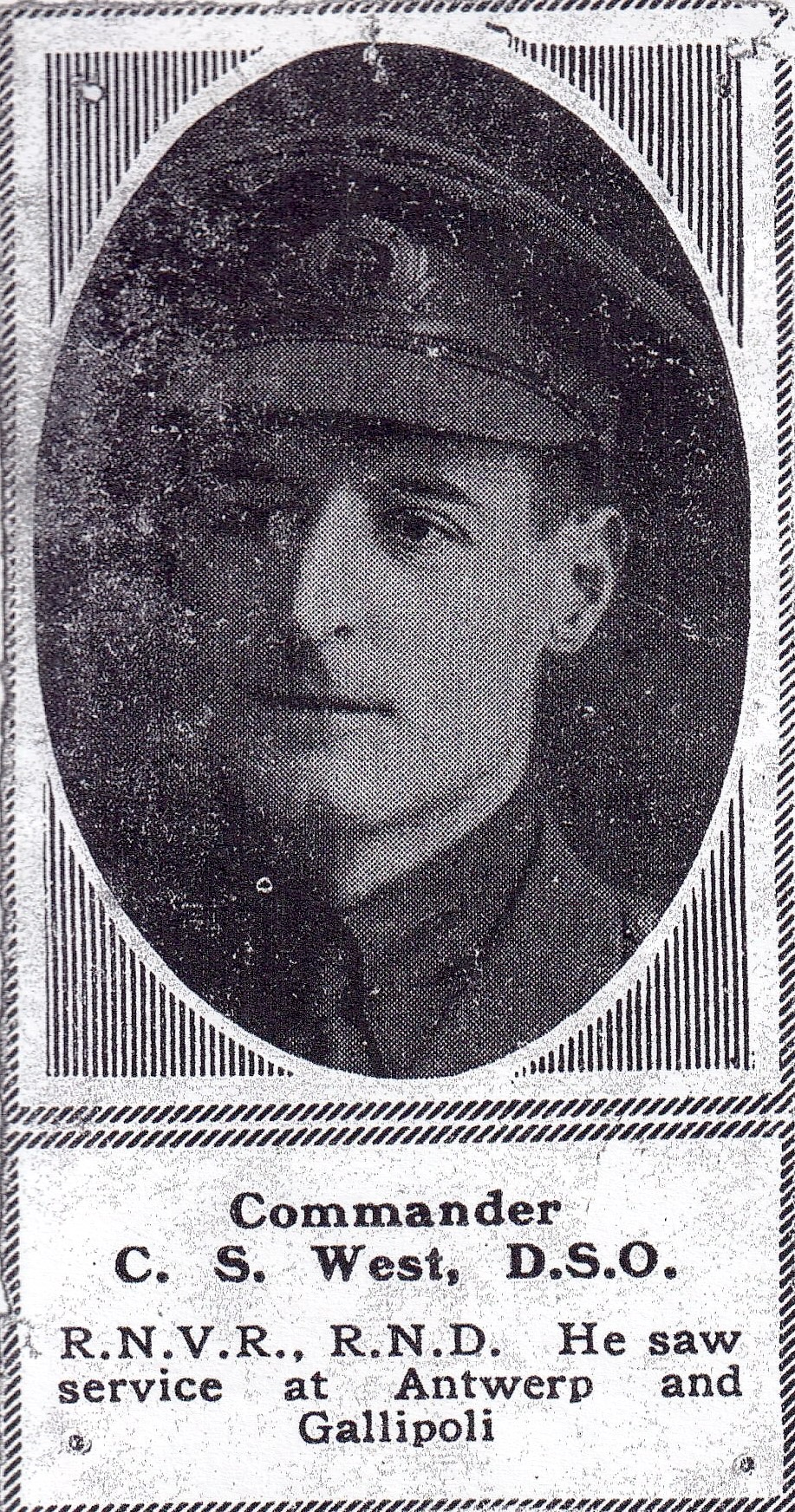The outstanding Great War Royal Naval Division D.S.O. group of four awarded to Commander C. S. West, Royal Naval Volunteer Reserve, who first saw action in Hawke Battalion at the defence of Antwerp in October 1914, prior to escaping in disguise from internment in Holland. He subsequently served as second-in-command of Collingwood Battalion in Gallipoli, where he was severely wounded at Krithia in June 1915, and as C.O. of Howe Battalion on the Western Front, where he was killed in action at Welsh Ridge in December 1917 Distinguished Service Order, G.V.R., silver-gilt and enamels, with integral top ribbon bar; 1914 Star, with clasp (Lieut. C. S. West, R.N.V.R. Hawke Btn. R.N.D.); British War and Victory Medals, with M.I.D. oak leaves (Lieut. C. S. West, R.N.V.R. Hawke Btn. R.N.D.) together with Memorial Plaque (Charles Skeffington West, mounted court-style for display, extremely fine (5) £4,000-£5,000 --- Importation Duty This lot is subject to importation duty of 5% on the hammer price unless exported outside the UK --- --- Provenance: Spink, November 2010. D.S.O. London Gazette 17 April 1917: ‘For conspicuous gallantry and devotion to duty. He rendered invaluable service by most ably guiding and placing companies of the battalion in their battle positions within 400 yards of the enemy. He worked continuously under heavy hostile shell fire, and was largely responsible for the success of the operations.’ Charles Skeffington West was born at Temple Mead Rectory, Longford, Ireland on 22 April 1886, the son of a clergyman and a cousin of Lieutenant-Colonel R. A. West, V.C., D.S.O., M.C. Having attended St. Clare School, Walmer, young Charles entered the Royal Navy as a Cadet in Britannia in January 1901 and served as a Midshipman on the China Station, prior to being invalided ashore as a Sub. Lieutenant in January 1905. He subsequently attended Trinity College, Cambridge. Commissioned as a temporary Lieutenant in the Royal Naval Volunteer Reserve on outbreak of hostilities in August 1914, he was quickly drafted to Hawke Battalion in the Royal Naval Division and embarked for Dunkirk as part of the 1st R.N. Brigade in early October. Having then taken part in the defence of Antwerp and been interned in Holland, ‘he, with two others, succeeded in escaping in disguise, thus avoiding having to give parole, May 1915.’ (The Distinguished Service Order 1886-1923, refers). Advanced to Lieutenant-Commander, West was next appointed 2nd-in-command of Collingwood Battalion, in which capacity he landed in Gallipoli at the end of May 1915. A few days later, the battalion was assigned to the third allied attack on Krithia, a costly action in which West was wounded on 4 June 1915 and his unit all but wiped out: of 70 officers and 1,900 ratings of the Naval Division who went into action that day, just five officers and 950 men returned to our lines. Following medical treatment at Alexandria, West returned to the peninsula as second-in-command of Howe Battalion, his old battalion having been temporarily disbanded on account of casualties. And he remained likewise employed until the evacuation of Gallipoli in January 1916. Howe Battalion was next embarked for France, where, in October 1916, it was deployed to the Somme, in readiness for the battle of the Ancre, in which the Naval Division’s objective was to be Beaucourt. On the morning of 13 November 1916, West’s Howe Battalion, as a part of a combined force, advanced behind the creeping barrage of the attack and successfully pressed home it’s objectives, including the German front line system. Beaucourt itself was secured on the following day, in an action in which Lieutenant-Colonel B. Freyberg of Hood Battalion won the Victoria Cross, but on ‘marching out’ of the front line, Howe Battalion mustered less than 100 men. The Naval Division was withdrawn from the battle area for two months’ rest. On returning to the front in January 1917, West and his comrades in Howe Battalion were quickly back in action, advancing on Grandcourt and spearheading the attack on Miraumont on 17-18 February, the latter being described as ‘brilliantly successful’ and resulting in West’s award of the D.S.O. But greater challenges lay ahead, not least the Naval Division’s costly part in the first battle of Gavrelle in April 1917, when it suffered losses of 170 officers and 3,624 ratings killed or wounded. One of the resultant casualties was the C.O. of Howe Battalion, who was invalided home in May 1917, and West now assumed command of the Battalion. A period of consolidation ensued, punctuated by occasional forays across No Man’s Land, a case in point being a successful night raid carried out by Howe Battalion against Gavrelle Trench on 20 July 1917: ‘The enemy losses in killed and prisoners alone exceeded our total casualties. The raid had found the enemy generally listless and ill-prepared. Their trenches were ill-constructed and badly tended, while many of the garrison were caught without arms or equipment.’ (The Royal Naval Division, by Douglas Jerrold, refers). At the end of September, the Naval Division was drafted in to participate in the much-delayed Flanders offensive, the main objective of which was Passchendaele ridge. And on 26 October 1917, as part of the 2nd Battle of Passchendaele, West’s battalion was detailed to attack towards Poelcappelle, an attack undertaken in terrible mud. Resultant casualties were high. Having then been rested, Howe Battalion rejoined the Naval Division on the Cambrai front in early December, moving into positions on Welsh Ridge. And it was here, in a major German counter-attack on the 30th, that West was killed: ‘ … on the Howe front, through no fault of the men on the spot, the situation was more serious. Simultaneously with the loss of the front line, a shell falling outside Battalion H.Q. had killed, Commander West and Lieutenant-Commander Alan Campbell … The deaths, moreover, of Commander West, of Patrick Shaw Stewart and of Alan Campbell, were in the nature of a grievous personal loss to innumerable officers and men of the Division. They had all served with the Division in the earliest Gallipoli days, and had each contributed much to its reputation, not only as a fighting organization but as the gathering place of so many men who were at once remarkably good company and of brilliant attainments … Commander West and Alan Campbell were killed by a shell falling at the entrance of their headquarters as they too were moving up to their front line.’ (ibid). West was buried in the British Extension of Metz-en-Couture Communal Cemetery. Sold with the recipient’s original M.I.D. certificate, dated 9 April 1917, in its original forwarding envelope addressed to ‘Mrs. West, Staverton, Wokingham, Berks.’









